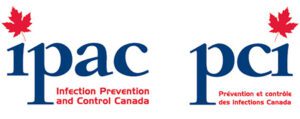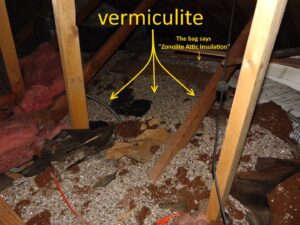The dangers of Vermiculite Insulation
 The dangers of vermiculite insulation…
The dangers of vermiculite insulation…
The dangers of vermiculite insulation are many, particularly asbestos impregnated vermiculite insulation. Vermiculite is a naturally occurring mineral that has the unusual property of expanding into fish-hook shapes or worm-like accordion shaped pieces when heated. The expanded vermiculite is a light-weight, fire resistant, absorbent, and odorless material. These properties allow vermiculite to be used to make numerous products, including attic insulation.
Do I have vermiculite insulation?
Vermiculite can be purchased in various forms for various uses. Sizes of vermiculite products range from very fine particles to large (coarse) pieces nearly an inch long. Vermiculite attic insulation is a pebble-like, pour-in product and is usually lightbrown or gold in color. In Canada the vermiculite that has been contaminated with asbestos was sold under the brand name Zonolite.
Is vermiculite insulation a problem?
Prior to its close in 1990, much of the world’s supply of vermiculite came from a mine near Libby, Montana. This mine had a natural deposit of asbestos which resulted in the vermiculite being contaminated with asbestos. Attic insulation produced using vermiculite ore, particularly ore that originated from the Libby mine, may contain asbestos fibers.
How does asbestos cause health problems?
Asbestos can cause health problems when inhaled into the lungs. If products containing asbestos are disturbed, thin, lightweight asbestos fibres are released into the air. Persons breathing the air may breathe in asbestos fibres. Continued exposure increases the amount of fibres that remain in the lung. Fibres embedded in lung tissue over time may result in lung diseases such as asbestosis, lung cancer, or mesothelioma. Smoking increases your risk of developing illness from asbestos exposure.
What should I do if I have vermiculite attic insulation?
DO NOT DISTURB IT AND ARRANGE TO HAVE IT REMOVED BY A CERTIFIED FIRM WITH EXPERIENCE IN REMOVING ASBESTOS AS MAPLE LEAF MOLD REMOVAL IS. Do not attempt to remove it yourself as any disturbance has the potential to release asbestos fibers into the air. Limiting the number of trips you make to your attic and shortening the length of those trips can help limit your potential exposure. EPA and Health Canada strongly recommend that:
- Vermiculite insulation should be removed from your attic safely. Due to the uncertainties with existing testing techniques, it is best to assume that the material may contain asbestos.
- You should not store boxes or other items in your attic if retrieving the material will disturb the insulation.
- Children should not be allowed to play in an attic with open areas of vermiculite insulation.
- If you plan to remodel or conduct renovations that would disturb the vermiculite, hire a professional asbestos removal firm like Maple Leaf Mold who are professionals trained and certified to handle asbestos to safely remove the material.
- You should never attempt to remove the insulation yourself. (https://mapleleafmold.ca/general-contractors-can-far-damage-suspect/)
What if I occasionally have to go into my attic?
EPA and Health Canada strongly recommend that homeowners make every effort not to disturb vermiculite insulation in their attics. If you occasionally have to go into your attic, current best practices state you should:
- Make every effort to stay on the floored part of your attic and to not disturb the insulation.
- If you must perform activities that may disturb the attic insulation such as moving boxes (or other materials), do so as gently as possible to minimize the disturbance.
- Leave the attic immediately after the disturbance.
- If you need work done in your attic such as the installation of cable or utility lines, hire trained and certified professionals who can safely do the work.
- It is possible that vermiculite attic insulation can sift through cracks in the ceiling, around light fixtures, or around ceiling fans. You can prevent this by sealing the cracks and holes that insulation could pass through.
- Common dust masks are not effective against asbestos fibres.
What are the next steps?
The guidance provided in this brochure reflects the current testing technology and knowledge of precautions one may take regarding vermiculite attic insulation. EPA is initiating further studies on vermiculite attic insulation and pursuing other asbestos related issues. Additional information will be provided to the public via the EPA and Health Canada websites and through additional outreach materials as it becomes available.
Is my health at risk from previous exposures to the asbestos in the insulation?
If you removed or disturbed the insulation, it is possible that you inhaled some asbestos fibres. Also the disturbance may have resulted in the fibres being deposited into other areas of the home. Exposure to asbestos increases your risk of developing lung disease. That risk is made worse by smoking. In general, the greater the exposure to asbestos, the greater the chance of developing harmful health effects. Disease symptoms may take several years to develop following exposure. If you are concerned about possible exposure, consult a physician who specialises in lung diseases (pulmonologist).
Where can I get information on testing or removal of the insulation?
EPA and Health Canada strongly recommend using a trained and certified professional to conduct removal work. Removing the insulation yourself could potentially spread asbestos fibres throughout your home, putting you and your family at risk of inhaling these fibres. For certified asbestos removal professionals in your area, refer to your local Yellow Pages. Your State Environmental Agency can confirm that the company’s credentials are current. Currently, there are specific technical issues involving vermiculite sampling that can complicate testing for the presence of asbestos fibres and interpreting the risk from exposure. EPA and Health Canada are recommending at this time that homeowners have vermiculite attic insulation tested for asbestos. As testing techniques are refined, EPA and Health Canada will provide information to the public on the benefits of testing that produce more definitive and accurate test results.
What if I have work-related exposure to vermiculite?
Workers who have had significant past exposure, or have significant ongoing exposure to asbestos, to vermiculite from Libby, or to other asbestos contaminated materials should consider getting a medical exam from a physician who knows about diseases caused by asbestos.
Where can I get more information?
Information on guidance regarding asbestos and the dangers of vermiculite insulation, including horticultural products, has previously been available on both the EPA and Health Canada website.
CBC article on new Asbestos legislation
Is mold the new Asbestos?

Maple Leaf Mold Inc. is a certified mold / asbestos removal and biological disinfection / air analysis company located in Toronto that uses certified IICRC technicians for all testing and remediation projects.
We are a professionally licensed firm experienced in testing, verifying and removing Mold / Asbestos / Lead and other environmental contaminants as well as providing disinfection services to control and kill biological contaminants.
Call 416-254-7256 to talk with us about your issue anytime.




 The dangers of vermiculite insulation…
The dangers of vermiculite insulation…